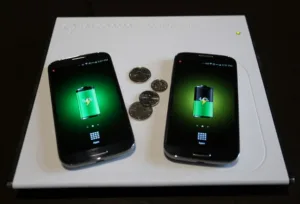Wireless charging awareness is widespread, according to a survey by IHS Markit. 25% of consumers have used the technology on a mobile device, and more than 80% have heard about it.
A new report by IHS Markit, which questioned consumers in the USA, UK and China, showed a continued rise in awareness over the past 12 months, growing from 36% in 2014 and 76% in 2015. Reactions have been ‘overwhelmingly’ positive; more than 98% of those who had used wireless charging said that they would do so again.
As seen above, there was a significant rise in awareness in 2015. IHS believes that this was largely due to the inclusion of wireless charging in popular mobile products such as Samsung’s Galaxy smartphones and the Apple Watch. Following this surge in adoption, the wireless charging receiver market grew more than 160% YoY last year, with annual shipments reaching 144 million units.
Vicky Yussuff, an analyst for IHS Markit, said, “Awareness is the first step in creating demand, and more products from mainstream manufacturers will need to be made widely available to keep the momentum going… Apple is expected to release a wireless-charging-enabled iPhone in the next 18 months. This would mean both of the top two key players in the smartphone market would be on board, no doubt pushing consumer awareness closer to the 100 percent mark.”
It is usage, not awareness, that translates into profits, though. Last year, 20% of consumers had used wireless charging, and 25% this year. This is a modest increase reflecting the relatively low volume of product launched that have taken place this year. IHS has previously forecast that 10% of 2016 smartphones would integrate wireless charging.
Despite delays in bringing products using the technology to market, customer retention remains high. Almost all consumers who have used wireless charging want it in their next mobile device.
The number of products available must increase, but the base technology must also be improved to compete with other features. Almost half (47%) of consumers ranked a long battery life as their most-wanted feature on a new smartphone, followed by fast charging. Mobiles with fast charging pose a significant threat to the wireless power industry.
Demand for faster wireless charging is growing, and suppliers are working on higher-power solutions. The Galaxy S7, for example, can be charged at speeds of up to 8W, compared to 5W for most other implementations. Fast wireless charging would negate the need for longer battery lives, said Yussuff, as consumers could ‘sip’ power using public charging points (more than 45% of wireless charging users said that they charge their devices more than once per day, compared to 25% of all other respondents.).
Half of all wireless charging users said that they had already used the feature in a public place. However, public wireless charging transmitters represented less than 2% of all transmitters shipped in 2015. Despite these low shipment volumes compared to standalone units, public wireless charging use will have a huge impact on the market; IHS expects it to drive transmitter growth over the next decade.

